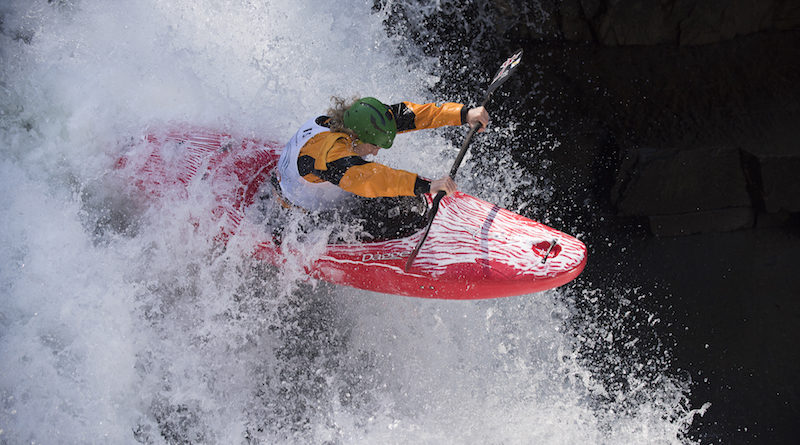Dropping In to Paddling Vermont’s Whitewater
You don’t have to be an expert to dive into paddling whitewater on Vermont’s roaring rivers this spring. Here’s how to get trained so you can start dropping ing.
As snow fell over the village of Middlebury on a Thursday morning in mid-February, Cortland Fischer, 22, sat poised in his kayak in a small eddy on the Otter Creek, tucked against the cobblestone arch of Middlebury’s downtown bridge. He back stroked his paddle and eyed the lip, sighting his line over the 18-foot waterfall.
Here, where water funnels through downtown, the Otter Creek feels like less of a slow river than a roaring behemoth. At a time of year when even the mighty New Haven is trapped in ice, the Otter Creek erupts at Middlebury Falls with tenacity, spitting foam and mist into the sub-freezing air and pounding at the discarded marble blocks at its feet—sharp reminders of the industry that once lit up the adjacent Middlebury Marbleworks.
It’s not a place where boaters love to swim. But that didn’t dissuade Fischer, or the other University of Vermont Kayak Club members, from spending a morning launching over the falls.
Seeing his window, Fischer, a UVM junior from Middlebury, pushed forward. “As you charge up to the lip, the whole world focuses into that one moment,” he said after. One wrong move, one caught paddle or a little misplaced weight can cause the boat to nosedive into the rapid below. “It’s all for chasing that split second of freefall when it all lines up and it’s just you and the water.”
And then, airborne in his bright blue boat, Fischer landed the drop, deftly paddling down the river and out of the froth to the snowy bank below.

February, when temperatures often dip well below freezing, may seem like the last time of the year you’d want to be rushing down a river, but in Vermont, it’s the start of a whitewater season that can last just a few short months.
From April 11, when the famous New Haven Ledges Race sends paddlers roaring down the New Haven from Lincoln to Bristol—drawing some of the top whitewater kayakers in the East—to the mellower party-like fun of the Onion River Ramble (a 10.5-mile race and group paddle down the Winooski, from Bolton to Richmond) on June 7, it’s a time of year when you start to see more boats on roofracks than skis.
On May 2 and 3, paddlers will also flock to Jamaica State Park, where a biannual dam release makes for some of the best whitewater of the season on the infamous West River. Similar releases are scheduled on the Deerfield River in western Massachusetts throughout May and June and on Fife Brook in North Adams, Mass., from April through October. These releases are occasions when boaters come together to paddle, camp and celebrate, and thanks to stretches of river with rapids as gentle as Class I and II, even novices can partake in the fun.
While technical stretches of river like the Otter Creek’s Middlebury falls or Bristol’s Ledges on the New Haven provide big water that challenges top experts, there are also plenty of novice or intermediate stretches of whitewater to be found around our region.
Whether you’re interested in dropping waterfalls, improving your paddling technique or learning the skills to tackle a week-long canoe trip on the Missisquoi, it can be hard to know where to start. From getting the gear to learning the paddle strokes and how to read a river, here are five ways to dive in to paddling whitewater like a pro.
Take a Clinic
If you really want to learn to paddle whitewater, consider taking an introductory clinic with a local retailer, guiding outfit or the Vermont Paddlers’ Club. Look for a course taught by an American Canoe Association-certified River Kayaking or River Canoeing instructor, or by the organization itself. These instructors can outfit you with gear, help you get comfortable in a whitewater boat and teach you the ins and outs of efficient paddling.
Formed in 1880, the American Canoe Association is the governing body that oversees instruction, racing and Olympic paddlesports in the United States. For a list of shops and outfitters, see Whitewater Resources.
Get Your Roll Down
Imagine you’re paddling through a rapid, water spraying all around you and suddenly you get knocked sideways by a wave. Thanks to the neoprene spray skirt that sits snug against your waist, you turn upside down but stay in your boat. With one quick snap of your hips and a sweeping bracing motion by your paddle, you pop back upright almost like a bobbing rubber duck, and paddle on down the river and out of the fray.
This is a C2C roll, and it’s one of the gateway skills that separates a novice paddler from an intermediate paddler.
“You can safely paddle into Class III whitewater with a good wet exit,” says Paul Carlile, who leads the Vermont Paddlers’ Club annual novice whitewater clinic, referring to the practice of pulling the skirt off of the kayak’s cockpit so the paddler ejects out of the boat when they capsize. “But if you want to push yourself into bigger water or more technical runs, you need to hone your roll.”
Carlile, who has been an American Canoe Association certified river kayaking and canoeing instructor for the last ten years, led eight practice sessions for whitewater paddlers at the indoor pool at Mt. Abraham Union High School in Bristol in Jan. and Feb. You can find the 61-year-old attempting more advanced roll maneuvers like the Back-Deck Rodeo Roll through the winter at twice-weekly pool clinics, which switch to NVU-Johnson’s pool come March and run through April 11. “Practicing rolls in a pool helps us stay fresh so that when the snow melts, we’re ready to hit the rivers.”
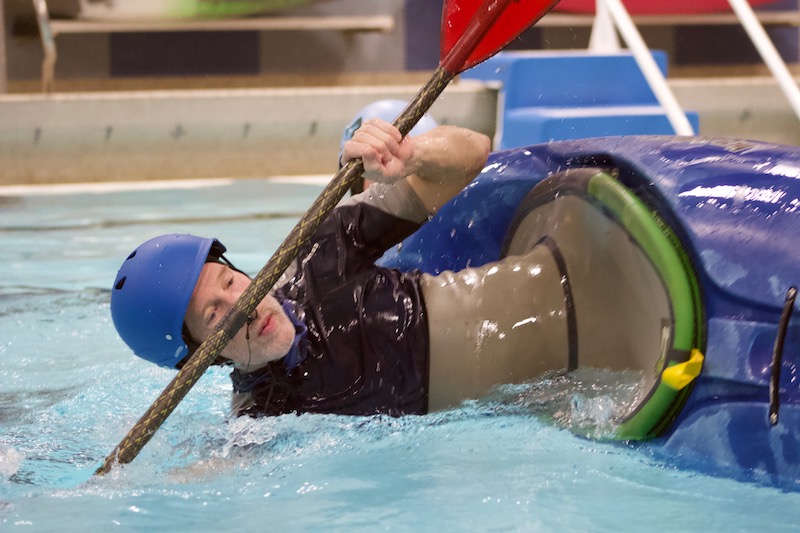
Be Prepared
The first rule of whitewater paddling is to never do it alone. The second is to always be prepared to get yourself (and your partner) out of a sticky situation.
“As a kayaker, you can’t always roll, and sometimes if you’re pushing yourself to progress appropriately on a river, there will be situations where you need to exit the boat quickly and safely,” says Chris Weed, president of the Vermont Paddlers’ Club. “This can be a big mental hurdle for some people.”
At Vermont Paddlers’ Club clinics, participants are required to practice by swimming a Class II rapid called Hugo on the Winooski River, with instructors waiting on shore by eddies at the base, ready to throw them a rope. “Swimming whitewater, you want to lie on your back facing downstream, keep your feet at the surface, and look for an opportunity to swim at the right time to get into an eddy,” says Weed. The key is to make sure your feet do not get caught in debris below the water surface.
To learn more about safety around and in whitewater, including how to layer and pack soft gear for a river trip, sign up for a safety clinic with the Vermont Paddlers Club (vtpaddlers.net) or Umiak Outdoor Outfitters’ Kayak Rescue Techniques clinic ($59, umiak.com) or an American Canoe Association Swiftwater Rescue course ($285, americancanoe.org) through Zoar Outdoor. For experienced boaters, a three-day Swiftwater Rescue Training course (SRT-I) from the Swiftwater Safety Institute will certify you to the same standard of training as professional river guides, using the training protocol employed by the U.S. Military Special Forces ($510, swiftwatersafetyinstitute.com).
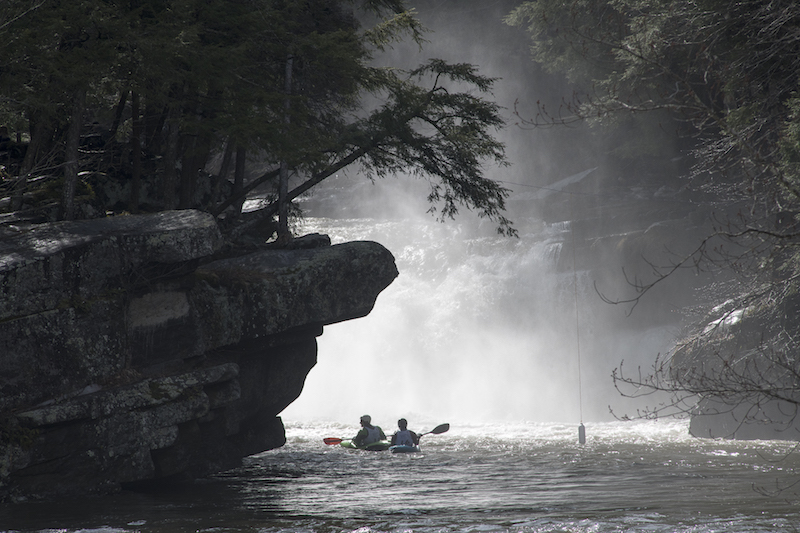
Gear Up
To paddle whitewater in Vermont, you need a short, maneuverable plastic, sit-in whitewater kayak that can turn on a dime in a river rapid. Generally, this means investing in one of three varieties of plastic kayaks: a creek boat, a whitewater boat or a recreational/touring boat.
Steve Brownlee, founder of Umiak Outdoor Outfitters in Stowe and Richmond, recommends that novice paddlers consider purchasing a more affordable recreational river boat of about 10 feet in length for their first kayak, such as the Dagger Blackwater 10.5 (a typical whitewater boat is less than nine). “You can roll and run a Class II or even Class III rapid in
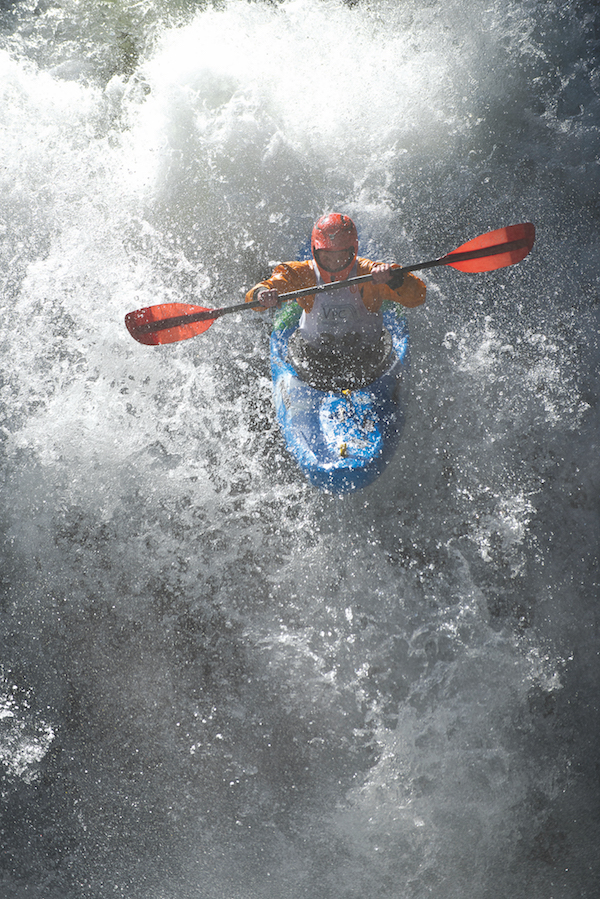
one of these slightly longer boats, and the extra length offered by the retractable skeg will let you track better in flatwater,” he says.
Buying a boat can be a big investment, with an entry-level whitewater boat starting at about $1,000 new. Whitewater kayaks are designed to be maneuvered with a performance fit. “Much like your alpine ski boot, this is something you’ll want to demo first at a local shop,” says Brownlee. “If you don’t have the right fit in the cockpit, you won’t have very good control when paddling and you won’t have a good time out there.”
New paddlers will also need to invest in a paddle, Type III foam life jacket certified by the U.S. Coast Guard and suitable for whitewater paddling, a neoprene spray skirt to hold them in their kayak and a helmet.
Brownlee recommends the WRSI Current ($99) as an affordable but highly reputable helmet for beginners. For a life jacket, consider Astral’s USCG III Abba or Norge ($139.95). Try a longer, straight-shafted retractable paddle with a small or medium-sized blade, such as the Werner Paddles Desperado CF 1 Piece Straight Shaft ($175).
If you decide you like the sport, you may eventually want to invest in your own dry suit or wetsuit so you can paddle Vermont’s snowmelt-fed rivers at peak flow in April and May. “Consider taking a lesson and renting gear you are interested in buying,” says Brownlee. “Or head to one of the many shops that offer used whitewater gear that’s been inspected by experts.”
Find Your Crew
“One of the things that is so cool about paddling is that here you are in this whitewater that looks like pure chaos. As an experienced paddler, you can see the line. You see different things, you break it into bite-sized pieces, and you find the path through this apparent chaos,” says instructor Paul Carlile.
And part of how you do that is by paddling with people who are better than you are. Most paddlers never paddle whitewater alone, for their safety.
“There are a lot of paddlers in the area who have their group. This is especially true with the really elite, advanced paddlers,” says Carlile. “The intensity of the sport and the nature of the activity means that people form these pretty incredible bonds with their paddling posses. Joining a group like the Vermont Paddlers’ Club, where people are participating because they want to be mentors is a great way to meet people with like abilities and interests.”
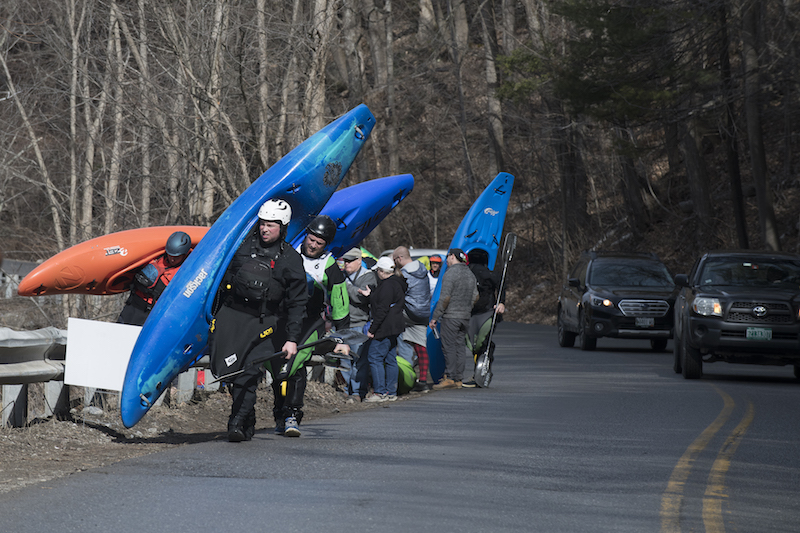
Take Your First River Trip
According to Chris Weed, Vermont isn’t known for its big whitewater rivers, but for the myriad streams and creeks that tumble out of the mountains, offering technical and exciting paddling for a variety of paddler ability levels. “A lot of these creeks move through beautiful woodland. When you paddle them, even at high water, you get a completely different perspective on the landscape, particularly up in the mountains,” says Weed, who’s been paddling Vermont’s creeks since the 1980s.
“There’s a longstanding Vermont connection between skiing and whitewater paddling. Navigating a tight and techy river is a bit like tree skiing. You look where you want to go, you move with your hips and you shift your weight subtly, testing the edge of your boat to push you forward, over the edge.”
The seasonal nature of the flows means that, come March or April, boaters will pull over by the side of the road to share beta and compare stream flows.
And in the Green Mountains, you can find whitewater adventure and thrills on a novice’s scale (see Rivers to Run). Be sure to check the American Whitewater Association’s website for river flow and other information about rapids along these routes. americanwhitewater.org
Here are 5 great Vermont rivers for novice whitewater paddlers.
Featured Photo: A kayaker punches through on the New Haven River. Photo by Caleb Kenna.

